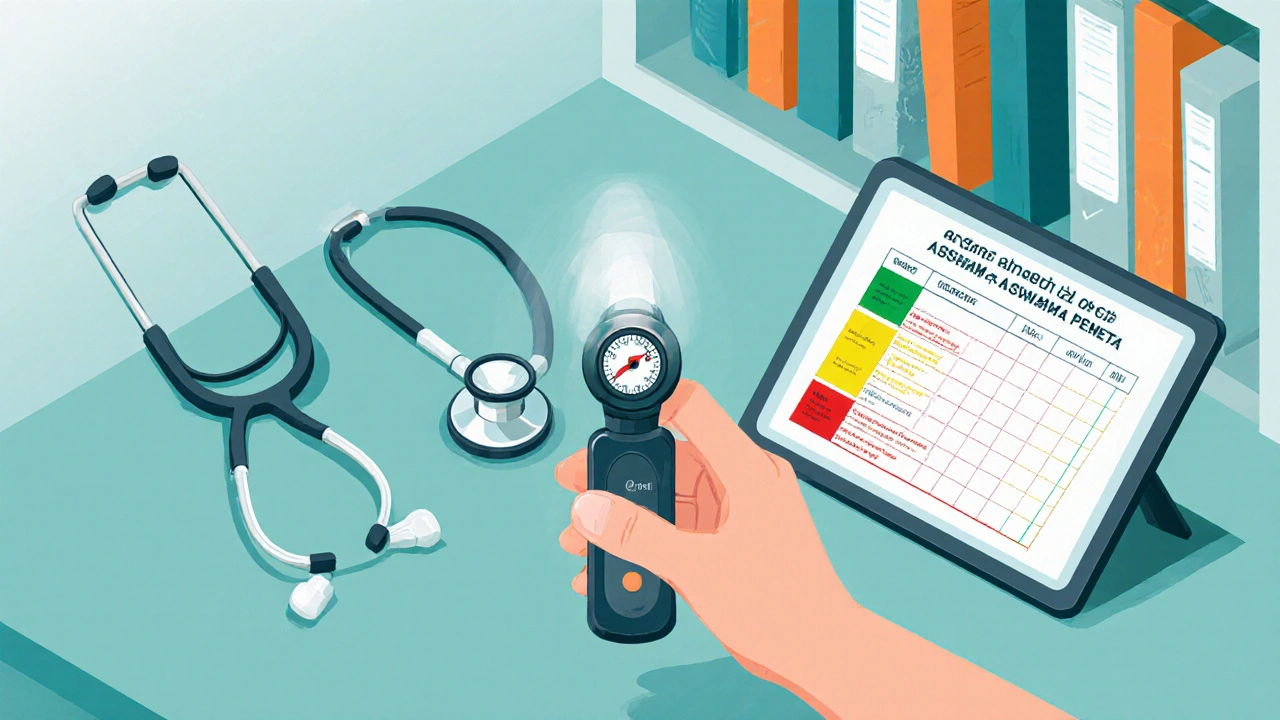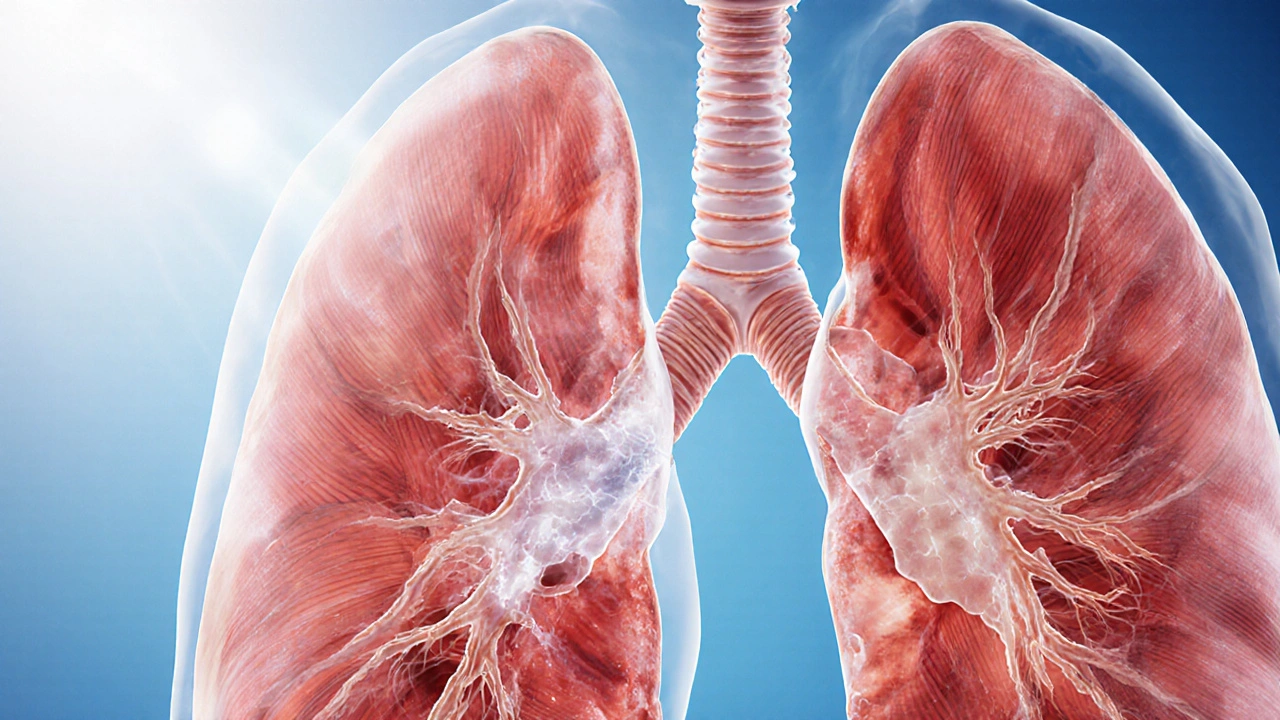7 Oct 2025
- 13 Comments
Asthma Symptom Checker
Your Results
When you hear the term bronchial asthma is a chronic lung condition marked by airway inflammation, tightening, and excess mucus, you might wonder how it actually feels day‑to‑day. The short answer: it’s a disease that makes breathing harder during flare‑ups, but with the right knowledge you can keep those episodes under control.
Key Takeaways
- Bronchial asthma is caused by a mix of genetics, allergens, and irritants that trigger airway inflammation.
- Typical symptoms include wheezing, shortness of breath, chest tightness, and a persistent cough.
- Diagnosis relies on lung‑function tests such as spirometry and peak flow monitoring.
- Treatment splits into quick‑relief (bronchodilators) and long‑term control (inhaled corticosteroids, leukotriene modifiers, etc.).
- Identifying and avoiding personal triggers, plus having an asthma action plan, are essential for daily management.
What Exactly Is Bronchial Asthma?
Bronchial asthma affects roughly 340million people worldwide, according to the World Health Organization. It’s not a single disease but a collection of patterns where the airways become overly sensitive. When a trigger hits, the muscles around the bronchi contract, the lining swells, and mucus spikes, narrowing the passage for air.
Because the condition is variable, some people experience symptoms only during certain seasons, while others have daily issues. The good news is that most individuals can achieve good control with a combination of medication and lifestyle tweaks.
Primary Causes & Risk Factors
There’s no single cause, but a handful of factors show up again and again. Understanding them helps you spot potential problems before they flare.
- Allergens - pollen, dust mites, pet dander, mold spores. These tiny particles interact with the immune system, prompting it to release histamine and other chemicals that inflame the airways.
- Genetic predisposition - If a parent or sibling has asthma, you’re more likely to develop it yourself.
- Respiratory infections - Especially viral infections in early childhood can set the stage for chronic airway sensitivity.
- Air pollution - Fine particulate matter (PM2.5) and ozone from traffic or industrial sources irritate the lungs and raise the risk of asthma attacks.
- Occupational exposures - Jobs that involve chemicals, dust, or fumes (e.g., paint spray, grain handling) can trigger work‑related asthma.
- Smoking - Both active smoking and second‑hand smoke damage airway lining and increase inflammation.
Often, several of these factors combine in a single person, resulting in a personalized trigger profile.

Spotting the Symptoms
Asthma symptoms can vary with intensity, but the core signs tend to follow the same pattern:
- Wheezing - a high‑pitched whistling sound during exhalation.
- Shortness of breath - feeling like you can’t get enough air, especially during exercise.
- Chest tightness - a sensation of pressure or squeezing.
- Persistent cough - often worse at night or early morning.
Because these symptoms overlap with colds or allergies, a formal test is needed to confirm asthma.
How Doctors Diagnose Asthma
Two tools dominate the diagnostic process:
- Spirometry is a lung function test that measures the volume and speed of air you can exhale. A reduced forced expiratory volume in one second (FEV1) that improves after a bronchodilator indicates reversible airway obstruction, a hallmark of asthma.
- Peak flow meter is a handheld device that records the highest speed of exhaled air. Regular readings help track variability and identify early warning signs.
Doctors also ask about symptom patterns, family history, and exposure to known triggers. In some cases, allergy testing pinpoints specific allergens that exacerbate asthma.
Treatment Overview
Asthma medication falls into two broad categories: quick‑relief (rescue) and long‑term control (controller). Understanding the role of each helps you use them correctly.
| Aspect | Quick‑Relief (Bronchodilator) | Controller (Inhaled Corticosteroid, etc.) |
|---|---|---|
| Primary purpose | Open airways instantly during an attack | Reduce chronic inflammation and prevent attacks |
| Typical onset | Seconds to minutes | Hours to days (needs regular use) |
| Common examples | Albuterol, levalbuterol (short‑acting β2‑agonists) | Fluticasone, budesonide (inhaled corticosteroids), montelukast (leukotriene receptor antagonist) |
| Frequency of use | Only when symptoms appear | Every day, regardless of symptoms |
| Side‑effects | Rapid heartbeat, jitteriness | Hoarseness, oral thrush (can be minimized with mouth rinsing) |
Most guidelines recommend a step‑wise approach: start with low‑dose inhaled corticosteroids and add a long‑acting bronchodilator if control remains poor. During an acute flare, a short‑acting bronchodilator provides immediate relief.

Managing Triggers & Lifestyle Adjustments
Medication alone isn’t enough if you keep walking into the same triggers. Here’s a practical checklist:
- Keep windows closed during high pollen days; use air purifiers with HEPA filters.
- Wash bedding in hot water weekly to reduce dust‑mite load.
- Maintain a smoke‑free home; ask visitors not to smoke inside.
- Track indoor humidity; aim for 30‑50% to deter mold growth.
- Carry your rescue inhaler at all times-especially during exercise or travel.
- Use a written asthma action plan that outlines medication doses for green (stable), yellow (worsening), and red (emergency) zones.
Regular physical activity can improve lung capacity, but start slowly and use a reliever inhaler before exercise if you have exercise‑induced symptoms.
Next Steps & Troubleshooting
If you’re newly diagnosed, schedule a follow‑up after 4-6 weeks to review your control level. Keep a symptom diary noting peak flow readings, trigger exposure, and medication use. If you notice increased night‑time coughing or need your rescue inhaler more than twice a week, it’s time to discuss stepping up controller therapy with your doctor.
For people who already feel stable, annual reviews still matter. Lung function can decline with age, and new allergens can appear (e.g., moving to a different climate).
Frequently Asked Questions
Can adults develop asthma for the first time?
Yes. While many cases start in childhood, adult‑onset asthma is common, especially when exposure to occupational irritants or smoking triggers airway hyper‑reactivity.
Is it safe to stop inhaled corticosteroids once symptoms improve?
Stopping abruptly can lead to rebound inflammation and more frequent attacks. Doctors usually taper the dose slowly while monitoring control.
How often should I use a peak flow meter?
For well‑controlled asthma, a weekly reading is enough. If your asthma is unstable, record twice daily (morning and evening) and note any declines.
Are natural remedies like honey or herbal teas effective?
They may soothe a cough but do not treat the underlying inflammation. Rely on prescribed medication for control; use natural remedies only as complementary measures after checking with your clinician.
What should I do during a severe asthma attack?
Take two puffs of a fast‑acting bronchodilator (e.g., albuterol) immediately, sit upright, and call emergency services if you don’t improve within 5‑10 minutes. Having a spacer device can improve medication delivery.


Javier Garcia
October 7, 2025Asthma triggers can be sneaky, so keep a diary of what flares you up.
christian quituisaca
October 10, 2025When you’re juggling asthma, remember it’s a team sport between you, your doctor, and the environment. Knowing your personal trigger palette-whether it’s pollen, pet dander, or that sneaky dust mite-lets you craft a defense plan that feels like a personalized shield. A daily inhaled corticosteroid works behind the scenes, reducing inflammation so you don’t constantly hear that wheeze. Keep a peak‑flow meter handy; watching the numbers dip before you feel short of breath can be a game‑changer. And don’t forget to rinse your mouth after each inhaler use to spare yourself from pesky thrush.
Donnella Creppel
October 13, 2025Okay, so let’s talk about THAT *so‑called* “mild” asthma-yeah, the one you think you can ignore!!! It’s like a silent thief, creeping in when you’re asleep, and you’ll wake up coughing like a banshee. People love to downplay it, saying “just a little cough,” but the airway inflammation is still there, simmering, waiting for the next pollen storm. Trust me, you’ll thank yourself later if you start tracking triggers NOW, not later. Also, rinse that inhaler mouthpiece-seriously, oral thrush is NOT a badge of honor.
Jarod Wooden
October 16, 2025From a pathophysiological standpoint, bronchial hyper‑responsiveness constitutes the core feedback loop that perpetuates episodic airflow limitation. The rapid β2‑agonist acts on adrenoceptors to induce smooth‑muscle relaxation, yet reliance on rescue inhalers without an adequate anti‑inflammatory regimen precipitates receptor desensitization. Therefore, a stepwise escalation to low‑dose inhaled corticosteroids is non‑negotiable for long‑term disease modulation. Ignoring this algorithmic framework is tantamount to professional negligence.
lee charlie
October 19, 2025Managing asthma is a marathon not a sprint and every small win matters. Keep your rescue inhaler within arm’s reach especially on workout days and remember to hydrate. Tracking symptoms in a simple notebook can reveal hidden patterns you didn’t notice before. If you ever feel like the meds aren’t enough talk to your provider about a possible combination therapy. You’ve got this and the community is cheering you on.
Greg DiMedio
October 21, 2025Wow, look at you dropping fancy terms like a textbook-how original. Maybe next time you could explain them in plain English so the rest of us don’t need a PhD to breathe.
Badal Patel
October 24, 2025Esteemed readers, permit me to elucidate the catastrophic ramifications of neglecting one’s pulmonary stewardship; indeed, the specter of uncontrolled asthma looms like a tempest over the unsuspecting populace. The indiscriminate inhalation of irritants, be they urban smog or indoor mold, orchestrates a symphony of inflammation that culminates in relentless nocturnal coughs and unforgiving bronchospasms. Such a despotic condition demands immediate rectification through regimented pharmacotherapy and vigilant environmental control, lest the sufferer be condemned to a life of perpetual dyspnea.
KIRAN nadarla
October 27, 2025Your prose, while flamboyant, suffers from egregious comma splices and redundant adjectives; a concise sentence would convey the same warning without the melodramatic excess. Moreover, the term “despotic condition” is a misnomer; asthma is a medical condition, not a tyranny.
Kara Guilbert
October 30, 2025Honestly, if you keep ignoring those night coughs you’re basically playing with fire and it’s just not right to put your health on the back burner.
Sonia Michelle
November 2, 2025From a philosophical perspective, the act of postponing self‑care reflects a deeper dissonance between intention and action, and reconciling that gap requires both mindfulness and concrete steps toward healthier habits.
Neil Collette
November 5, 2025Asthma, in its many guises, is not merely a mechanical malfunction of the lungs but a profound dialogue between genetics, environment, and personal agency.
When you inhale an allergen, mast cells unleash histamine, leukotrienes, and a cascade of cytokines that transform a quiet airway into a battlefield.
This inflammatory onslaught narrows the bronchi, prompting the characteristic wheeze that many of us have come to recognize even in the night.
Yet, the narrative does not end at pathophysiology; it extends into the sociocultural realm where access to medication, education, and clean air can dictate outcomes.
Consider the child raised in a household where smoking is prevalent; the secondhand smoke not only irritates but also primes the immune system for hyper‑reactivity.
Conversely, the athlete who trains under a meticulously crafted asthma action plan can achieve peak performance, debunking the myth that asthma equals weakness.
The cornerstone of chronic management lies in inhaled corticosteroids, which, by dampening inflammation, reduce the frequency of exacerbations.
However, adherence falters when patients perceive the inhaler as a nuisance or fear side effects such as oral thrush.
Education, therefore, becomes the bridge between prescription and proper use, empowering individuals to rinse their mouths and monitor peak flow daily.
Technology offers additional support; smartphone apps can log symptoms, remind users to medicate, and even alert caregivers during severe attacks.
Nonetheless, no app can replace the tactile reassurance of a well‑fitted spacer delivering medication deep into the lower airways.
Healthcare providers must also stay vigilant for comorbidities like allergic rhinitis or gastroesophageal reflux, which can masquerade as uncontrolled asthma.
Addressing these overlapping conditions often yields a dramatic improvement in respiratory comfort.
Environmental control measures-air purifiers, humidity regulation, and allergen‑proof bedding-serve as non‑pharmacologic allies in the daily battle.
Regular follow‑up visits, ideally every four to six weeks after initiating therapy, allow for dose titration and assessment of control.
In sum, mastering asthma demands an integrated approach that harmonizes medication, lifestyle adjustments, and continuous collaboration with healthcare professionals.
James Lee
November 8, 2025Well, that was a lot of hot air for a condition that most folks just manage with a puff and a prayer.
Dennis Scholing
November 11, 2025While brevity has its virtues, a comprehensive understanding of asthma-such as the one you just summarized-helps ensure patients receive the nuanced care they deserve and can avoid preventable complications.